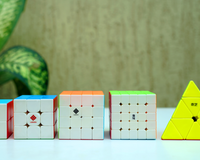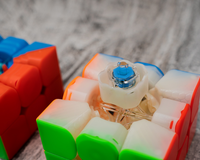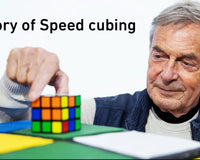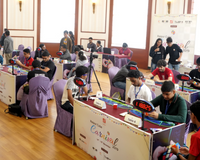This blog will be all about a slightly controversial, and rather underestimated aspect of speedcubing: the 15 seconds of the inspection time. In the sea of fancy algorithms and tricks, we often overlook this. We focus more on the solving itself rather than the planning, which hinders the development of using inspection. If you struggle with this step, which you may not even realize, then keep reading, as I will cover everything you need to know to improve.
A brief history of inspection time:
At the first-ever World Rubik’s Cube Championship in 1982, the 15-second inspection rule was introduced. Even after 21 years, when speedcubing returned in 2003 with the formation of the WCA, they stuck to the 15-second rule.
A minority of the community feels that we should be timing solves from the first look at the cube to when it is solved, and that inspection time is arbitrary. Well, you have to disagree, because we wouldn’t see such beautiful solutions from speedcubers who plan pseudo slots, one-look F2L, and all sorts of crazy stuff.

Minh Thai - winner of Rubik’s Cube World Championship 1982 (22.95 former world record solve)
As you read ahead, I will be going through ways you can improve your inspection by:
- Improvement methods
- Identifying and correcting your bad habits during the inspection
- Why you should plan cross + first F2L pair (advanced)
- Other Important notes to keep in mind for Color Neutral solvers
Note that I will generally be talking about 3x3 with the CFOP method in this blog, but methods to apply to other puzzles are mentioned when necessary.
Basic Improvement Methods:
This is a very common method used by speedcubers at all levels. You scramble up your cube and give yourself unlimited inspection time to plan as much as you comfortably can. After that, put on a blindfold and do the moves you had planned.
Do not worry if you find it difficult at first and you cannot do it accurately. As you put in more and more effort, this will improve over time and benefit you in the end. 
If you still think it is hard for you, try memorizing how the pieces move when you do common triggers for that certain step (for example, R’ D R for 3x3 cross, Rw U’ Rw’ for 4x4 centers, etc).
You should work on your cross/center solutions to be more efficient by watching walkthrough solves from pro speedcubers on YouTube.
You can also do untimed solves and experiment to see how you can reduce the number of moves.
If your starting step has fewer moves overall, then you don’t have to put too much effort into visualizing how the pieces move.
Identifying your bad habits during inspection:
Here is a list of bad habits that you might have fallen into for inspection:
- Using too little time.
- Not getting nerves under control
- (if you are color neutral) looking for too many cross solutions
Using too little time
Maximizing your inspection time helps you to be more confident in your solution. You can put in more effort to look further, possibly into the next step and beyond. You do not have to use the full 15 seconds and risk a +2 or DNF. You should ideally use up to 10-11 seconds.
Not getting nerves under control
Instead of picking up and spamming your moves on the cube, you can use 1-2 seconds to calm yourself down while/before starting the timer. Use techniques like taking some deep breaths, revising your solution, and visualizing getting a good time. Also remember that since you already have an idea of how the solve will go, you have a bit of uncertainty taken away.
(If you are color neutral) looking for too many cross solutions
If you are color neutral, you should always stick to the solution you first looked into and have used a chunk of your inspection time for. Even if your solution is subpar, it is rarely viable to look for an entirely new solution in a small amount of time. I have tried it at official competitions before and more often than not, it has resulted in a bad time.
Why you should plan your first F2L pair:
Whenever cubers who are trying to become sub-10 tell me they are struggling, I ask them this question: Do you plan your first pair?
If they answer “no”, that’s where I say the problem lies.
Think about it this way when you don’t plan your first F2L pair:
You have solved the cross. You then take a relatively long time to solve the first one or two pairs because the pieces are scattered around the cube. After which you pick up the pace for the remaining pairs as the pieces are easily visible.
But, if you plan and solve your cross + first pair in one fluid motion, you save a chunk of that relatively longer time.
You can use the improvement methods written above in this blog to help. You can also watch example solves from pro speedcubers to understand how they go about cross + first pair.
Important notes to keep in mind for colour neutral solvers
- You should be fully focused on planning your first pair. This is where your real advantage lies over non-CN solvers. Since you are generally doing easier cross-solutions, it is logical that you can comfortably find your first pair.
- Understand that your inspection looks different to a non-CN solver. As soon as the cover is lifted, you should look for blocks or free pairs. You should then build your cross based on those pieces of information.
For example, if I see a blue free pair, I will think about building the blue cross along with preserving that pair to have an easy cross + first pair.
That’s all for this blog! I really hope this helps you improve and that I was able to add some value. Thank you for reading!






























